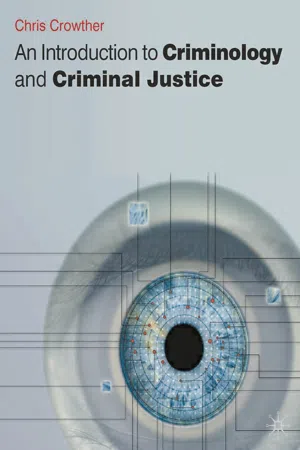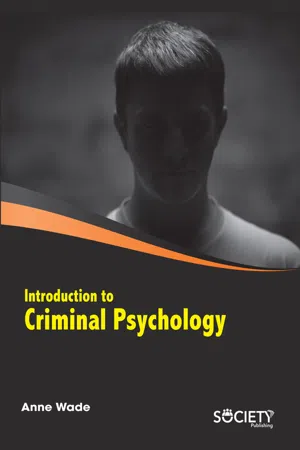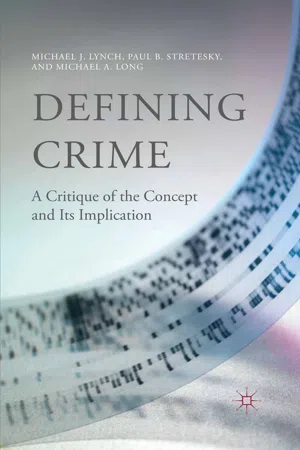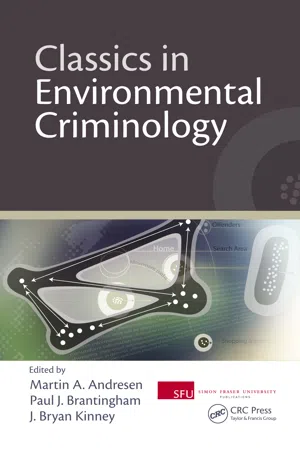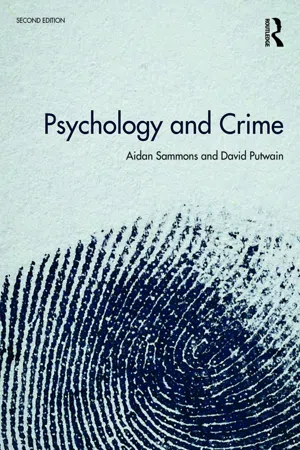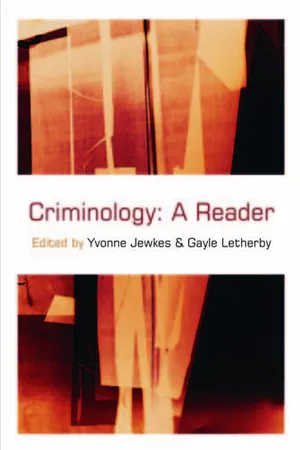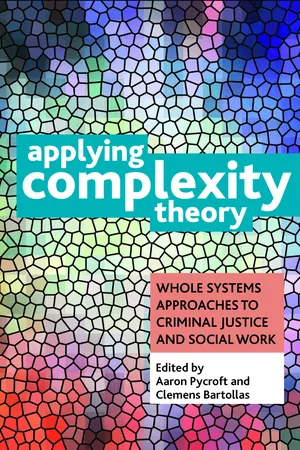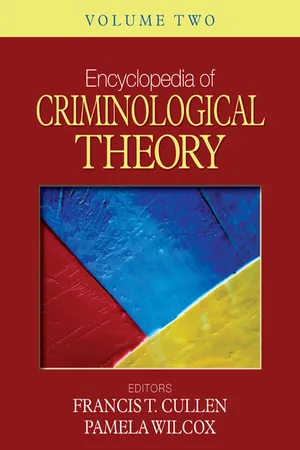Social Sciences
Interactionism Crime
Interactionism in the study of crime focuses on how individuals and society interact to construct definitions of crime and deviance. It emphasizes the importance of social interactions, labeling, and the subjective nature of crime. Interactionist perspectives highlight the role of social processes in shaping criminal behavior and the significance of societal reactions to individuals labeled as criminals.
Written by Perlego with AI-assistance
Related key terms
1 of 5
11 Key excerpts on "Interactionism Crime"
- eBook - PDF
Sociology
The Essentials
- Margaret L. Andersen; Howard F. Taylor, Margaret Andersen, Howard Taylor(Authors)
- 2016(Publication Date)
- Cengage Learning EMEA(Publisher)
Each perspective traces criminal behavior to social condi-tions rather than only to the intrinsic tendencies or personalities of individuals. ◆ Table 7.2 Sociological Theories of Crime Functionalist Theory Symbolic Interaction Theory Conflict Theory Societies require a certain level of crime in order to clarify norms. Crime is behavior that is learned through social interaction. The lower the social class, the more the individual is forced into criminality. Crime results from social structural strains (such as class inequality) within society. Labeling criminals and stigmatizing them tends to reinforce rather than deter crime. Inequalities in society by race, class, gender, and other forces tend to produce criminal activity. Crime may be functional to society, thus difficult to eradicate. Institutions with the power to label, such as prisons, actually produce rather than lessen crime. Reducing social inequality in society is likely to reduce crime. © Cengage Learning Some deviance develops in deviant communities, such as the neo-Nazis/“skinheads” shown marching here. Such right-wing extremist groups have increased significantly in recent years, as monitored by the Southern Poverty Law Center. Jim West/Alamy Copyright 2017 Cengage Learning. All Rights Reserved. May not be copied, scanned, or duplicated, in whole or in part. Due to electronic rights, some third party content may be suppressed from the eBook and/or eChapter(s). Editorial review has deemed that any suppressed content does not materially affect the overall learning experience. Cengage Learning reserves the right to remove additional content at any time if subsequent rights restrictions require it. 160 CHAPTER 7 Measuring Crime: How Much Is There? Is crime increasing in the United States? One would cer-tainly think so from watching the media. Images of vio-lent crime abound and give the impression that crime is a constant threat and is on the rise. - eBook - ePub
Deviance and Crime
Theory, Research and Policy
- Walter DeKeseredy, Desmond Ellis, Shahid Alvi(Authors)
- 2014(Publication Date)
- Routledge(Publisher)
Third, while the metaphor of multi-player games such as ice hockey, football, or baseball may be applied to symbolic interaction and society, Mead’s game has one very important and distinctive property: in the course of interacting with each other, self-images and the rules of the game may be changed. New self-images and rules may be created, some rules applied, and other’s not. Simply examining the game’s rules as they appear in the rule book will not tell you very much about how the game is actually played or about the course of the game. Games like ice hockey have an emergent quality to them, and the process of emergence must be studied directly. The game’s structure, its rules, and its competitive values should be taken into account, but the primary focus of analysis is the process of symbolic interaction. The large, many-player game called society emerges out of, and can be changed by, the symbolic interaction that takes place among individuals in such small-scale settings as homes, schools, workplaces, churches, and so on.Most sociologists who adopt a social psychological, symbolic interactionist approach to the study of deviant and/or criminal social behavior in these settings work with a set of sensitizing concepts bequeathed them by Mead. These include interaction, symbols, meanings, process, emergence, and self-concept. A few have borrowed concepts formulated by other theorists, and some have tried to combine Mead’s micro-sociological approach with a macro-sociological one.In Chapter 1 , we briefly described one type of interactionist theory that has been applied to the study of crime and deviance: the societal reaction/labeling perspective. There, we said that societal reaction/labeling theorists want to develop a sociological understanding of how people and behaviors come to be designated as criminal or deviant. This is very different from wanting to describe the causes of crime. Recall that for scholars such as Howard Becker (1973), nothing is inherently deviant or criminal. Rather, crime is a social construct or a label attached to a behavior during the course of social interaction between rule-makers and rule-breakers. Here, we introduce you to one major variant of the interactionist perspective: Sutherland’s differential association theory.Differential Association Theory
As originally formulated by Sutherland (1947) and later revised by Sutherland and Cressey (1966), differential association theory is an interactionist account of both conformity and deviation. However, because of its inclusion of motives, its emphasis on the original or random causes of deviance/crime, and its acceptance of the traditional notion that social control is caused by deviance instead of vise versa, differential association theory differs from the interactionist accounts reviewed in Chapter 1 - Chris Crowther-Dowey(Author)
- 2017(Publication Date)
- Red Globe Press(Publisher)
THE INDIVIDUAL AND CRIME This section: ឣ introduces a range of approaches used to explain crime by focusing on the individual offender ឣ identifies two broad approaches, positivism and classicism. This chapter concentrates on those criminological theories that focus on the individual offender. This is arguably the most obvious starting point for any criminological theory, because if offenders did not exist there would be no crime and no need for a criminal justice system. Moreover, it is the offender who is responsible for committing an offence, and offenders need to be held accountable for their actions. If any sense is to be made of criminal behaviour, then logically it is necessary to look closely at its source. Indeed this is exactly what the pioneers of criminology did in various works published from the late eighteenth century onwards (Hopkins Burke, 2005). However, taking the individual criminal as the starting point there is not a single explanation but a diverse range of competing theoretical arguments and perspectives. For example, classical approaches to criminology, which are described in much more detail below, argue that individuals are capable of free will and that they consciously choose how to behave. In other words, crime is a choice. This view is very popular today, and if you scan the pages of any tabloid newspaper you will read accounts of crime in which the offender is accused of being at worst evil and at best feckless and idle (Jewkes, 2004). The message behind the headlines is that criminals are responsible for their own actions, and that they alone are culpable or blameworthy. Writers belonging to another school of thought, known as positivism , have focused on those ways in which biology influences human behaviour, whereas others have focused on the psychological factors associated with criminality. Positivism holds that to a certain extent crime is ‘in the genes’, and psychological theories suggest that crime is ‘all in the mind’.- eBook - PDF
- Anne Wade(Author)
- 2020(Publication Date)
- Society Publishing(Publisher)
Historically, there are different theories that have used when it comes to understanding crime. Most of the time theories are referred to as being good if they provide foundation via which behavior can be understood and interpreted. The field of criminology typically borrows theories from different fields such as sociology , psychology, and biology. The behavior explained by the theories is that which is in violation of codified laws which exist within the society. Most of the theories borrowed from the various field provide empirical insights into factors that are perceived and expected to give an explanation to delinquency and criminal activities. Despite explanations on criminal behavior, there is no one theory that can give an explanation to all criminal activities due to their variations. Figure 7.1. Theories of criminal behavior. Theories of Criminal Behavior 173 Source: http://crime-study.blogspot.com/2011/04/three-theoretical-explana-tions-of-crime.html?m=1. The theories explain why crimes occur and therefore the motivations behind criminal activities. Each theory gives a different perspective on crime and therefore have their individual strengths and weaknesses. Some of the theories are also characterized with gaps and can only be applied to specific criminal activities as such. Given this it is safe to assume that right or wrong theories do not exist. The theories can be categorized into three biological theories, sociological theories, and psychological theories. 7.2. BIOLOGICAL THEORIES OF CRIME Biological theories of crime try to explain behaviors which contrast with the normal expectations of the society through examining characteristics of individuals. The theories are placed in categories that exist within a paradigm referred to as positivism or determinism. It claims that behavior including the violation of law are determined by factors which are beyond the control of a person. - Marko Nikolic(Author)
- 2019(Publication Date)
- Society Publishing(Publisher)
In context to the current thoughts, it is possible that sociological views will endure to dominate criminology for some time. Such kind of dominance decreases as the crime takes place in the framework of a social world irrespective of the contributing shades Research Methods in Criminal Justice and Criminology 36 recognized in its development. Due to this reason, the chief importance of the crime as well as criminal behavior is essentially social in nature and effective social policy will successfully restrict the criminal activity. 2.3.1. What Is Exactly Criminology Deal With? Due to various reasons, this is a tough question to answer. First is that, the field of criminology involves a huge number of distinct perspectives and the experts will generally have stable disagreements related the task of criminology. • Is it to clarify why individuals choose to commit crimes? • Is it to recognize the social conditions out of which the issues related to the crime emerge? • Is it to study what different societies understand by the term ‘crime’ at different times? • Is it to validate how common crimes imitate patterns of power as well as prejudice? • Is it to discover what it feels like to be a victim of crime? • Is it to recognize how society answers to offenders, how it penalizes them for their supposed transgressions? • Is it to explain why, ‘the rich get richer and the poor get prison’? • Is it to obtain practical solutions to inhibit crime from taking place in the first place? • Is it to find different ways of assimilating offenders and so depress them from repeating past crimes? The simple but discouraging answer is that the field of criminology is all about these things and others besides. Due to such great range of questions, interests, and perspectives, some have recommended that criminology is not a kind of academic discipline.- eBook - PDF
Defining Crime
A Critique of the Concept and Its Implication
- M. Lynch, P. Stretesky, M. Long(Authors)
- 2016(Publication Date)
- Palgrave Macmillan(Publisher)
5 Crime and the Individual W ithin criminology, there is a long history of the search for the causes of criminal behavior being dominated by micro- level explanations focused on the individual—that is, criminology is strongly associated with and influenced by microlevel studies of crime that direct attention to locating the causes of crime within an individual’s psychology or biology or their individual relation- ships to others and to social institutions. The assumption that the causes of crime are found in the individual may seem to make logi- cal sense. After all, people and their offending patterns are differ- ent and crime varies across individuals. Thus it would appear that variability in crime across individuals must have something to do with individuals themselves. The focus on the individual, espe- cially in a historical era dominated by the economic, social, and political relations of capitalism as a world economic system and its emphasis on individual-level achievement and success, appeals to the basic socialization experiences of people who live in most economically advanced nations (Turner 1988). From an early age, mechanisms of socialization and social institutions label and divide individuals into categories of achievement tied to them as individu- als. The idea that those who fail to achieve and possibly become criminals also reinforces common beliefs that criminals and non- criminals are different kinds of people and that individual efforts and choices have something to do with their criminal behavior and status. However, criminologists seem to forget that the study of crime did not begin with a focus on the individual. Early explanations of crime focused, instead, on society and social relationships. Andre Guerry and Adolphe Quetelet performed some of the earliest 72 DEFINING CRIME statistical studies of crime (see Beirne 1987). - eBook - PDF
- Martin A. Andresen, Paul J. Brantingham, J. Bryan Kinney, Martin A. Andresen, Paul J. Brantingham, J. Bryan Kinney(Authors)
- 2010(Publication Date)
- Routledge(Publisher)
This statement is in essence Thomas’s definition of the situation and Sutherland’s theory of differential association. Sutherland, Shaw, and McKay turned sociological criminology into a symbolic interactionist framework or paradigm, to use Ritzer’s terminology. This is the nonphysical organism interacting with the nonphysical environ-ment. I commented above how in the past ten years several radical sociologists have suggested bringing man back into sociology, bringing the beast back into sociology, and now bringing the physical environment back into sociol-ogy. The basic theme of this series of papers on criminal behavior [ American Behaviorial Scientist , Volume 20, Issue 2] involves a biosocial organism inter-acting with the physical environment. This model goes beyond the social factist model or the social definitionist model of behavior; it goes beyond behaviorism to a learning model based on genetics and psychobiology. Morris has observed that the Shaw and McKay data suggest that crimes are committed where the opportunity structure exists rather than where Criminal Behavior and the Physical Environment 443 specific attitudes of community members exist (T. Morris 1957: 94). Boggs (1965) found in her study of St. Louis that opportunity structures for crime differ from residential patterns of criminals. Baldwin (1974), a British social ecologist, has suggested that social area analysis as used by Shevsky and Bell is a poor ecological tool and is misleading when used to study crime rates. Social area analysis makes use of census tract data grouped accord-ing to economic status, family background, and ethnic and racial charac-teristics of the population. The assumption made is that one can correlate social variables with crime rates and tell something about why individuals commit crimes. Such statements appear in the works of sociological crimi-nologists such as Polk, Schmid, Willie, and Quinney (Baldwin 1974; Baldwin and Bottoms 1976: 19–24). - eBook - PDF
Psychology and Crime
2nd edition
- Aidan Sammons, David Putwain(Authors)
- 2018(Publication Date)
- Routledge(Publisher)
51 This chapter focuses on theories that explain offending in terms of the processes that happen between people. Social learning theory suggests that criminality is a set of learned attitudes and behaviours and there is an exploration of the role mass media might play in offending. Social-psychological and sociological perspec-tives suggest that crime is a consequence of relationships between individuals and groups and there is a discussion of three influential theories, labelling, self-fulfilling prophecy and social identity theory. Finally, there is a review of research into the role of social variables including poverty and the neighbourhood in crime. As with the previous chapters, the line between psychologically and socially oriented the-ories is somewhat arbitrary and most of these theories refer to both individual and social processes. C H A P T E R 5 Socially oriented explanations of offending Apply your learning Saffi has been caught shoplifting. She is 14 years old and has not been in trouble with the authorities before. She was with a group of young people who were chased by a store detective who suspected that they were stealing. Only Saffi was caught and the shop manager called the police, who arrested her and took her to the police station. Saffi admitted stealing some low-value items of jewellery. The arresting officer has a choice: she can arrange for Saffi to be formally cautioned and released with no further action or she can advise that Saffi be prosecuted. What justifications could be given for each course of action? What are the pros and contras? How could social theories of offending guide the officer’s decision? Social learning theory Social learning theory (SLT) originated in an earlier explanation of crime called differential association theory, which suggested that some individuals become chapter 5 Socially oriented explanations of offending 52 criminals and others not because of the different people they associate with (Suther-land, 1939). - eBook - PDF
Criminology
A Reader
- Yvonne Jewkes, Gayle Letherby, Yvonne Jewkes, Gayle Letherby(Authors)
- 2002(Publication Date)
- SAGE Publications Ltd(Publisher)
As a theoretical perspective, symbolic interactionism centres the cre-ative capacities of human beings and their ability to share understandings with one another. These general propositions direct attention towards the quality of the interactions which take place between people, how those interactions are understood, and how they become modified, refined and developed. This per-spective, then, shares common concerns with strain theory in addressing the general question of how behaviour comes to be understood as deviant (rather 26 c r i m i n o l o g y : a r e a d e r than criminal) and the role of shared norms and values in that process. In this latter respect the work of Howard Becker, with what came to be called labelling theory, has been particularly influential. There are two strands to Becker’s (1963) labelling theory: a concern to address how it is that a particular behaviour is labelled as deviant, and a con-cern to understand the impact of that labelling process. As Becker states: Social groups create deviance by making the rules whose infraction constitutes deviance, and by applying those rules to particular people and labelling them as outsiders. From this point of view, deviance is not a quality of the act the person commits, but rather a con-sequence of the application by others of rules and sanctions to an ‘offender’. The deviant is one to whom that label has been successfully applied; deviant behaviour is behaviour that people so label. (Becker, 1963: 9) In understanding deviance, then, importance lies with the reaction to the behaviour not the behaviour itself. This led Becker to construct a fourfold typology of possible labels (reactions) to perceived deviant behaviour: the falsely accused, the pure deviant, the conformist, and the secret deviant. This focus on the labelling process led criminologists and sociologists to think about criminal behaviour in quite a different way. - eBook - PDF
Applying Complexity Theory
Whole Systems Approaches to Criminal Justice and Social Work
- Pycroft, Aaron, Bartollas, Clemens(Authors)
- 2014(Publication Date)
- Policy Press(Publisher)
59 THREE Why do people commit crime? An integrated systems perspective Matthew Robinson Introduction Integrated Systems Theory (IST) has been referred to as ‘the most ambitious, comprehensive interdisciplinary attempt so far to move integration of criminological theory to new heights’ (Lanier and Henry, 2004, p 351).Yet, most people have never heard of it and the theory has received little attention in criminology, probably because of its complex, systems-based approach. IST is based on the positivist systems perspectives of Whitehead (1925), Lewin (1935), Murray (1938) and especially Miller (1978). Miller (1978) characterised human behaviour as a product of factors interacting among seven different living systems.This systems approach was first applied to criminological theory by C. Ray Jeffery, in his book Criminology: an interdisciplinary approach (Jeffery, 1990), which he called the ‘integrated systems perspective’ (ISP). ISP is a perspective – a way of looking at or studying crime – that is interdisciplinary in nature, meaning it integrates findings from numerous academic disciplines in order to better understand human behaviour. In response to the question ‘Why do people commit crime?’, IST asserts that there is no easy answer. This is because there is no single cause of crime, or any cause at all. Instead, lots of different things impact the likelihood of antisocial and criminal behaviour, and these things can be found at several levels of analysis. A level of analysis (see Figure 3.1) refers simply to a living system that survives on its own and that can be studied independently of the others (eg biologists study cells, neurologists study organs, psychologists study individual organisms, sociologists study groups, etc). ISP assumes that there are things (factors, concepts or variables) at each of these levels of analysis that influence the likelihood of antisocial behaviour. Most criminologists examine one or two levels of analysis across the - eBook - PDF
- Francis T. Cullen, Pamela Wilcox, Francis T. Cullen, Pamela K. Wilcox(Authors)
- 2009(Publication Date)
- SAGE Publications, Inc(Publisher)
Harming the adversary can also be more valued in that situation. Conclusion A possible concern regarding the social interac-tionist theory is that by focusing on the individual actor, rationality, and the immediate social- psychological and situational risk factors, atten-tion will be drawn away from the sociological explanations of violence. On the contrary, this 332 Ferraro, Kenneth F.: Risk Interpretation Model approach does not downplay the importance of structural and macro-social criminogenic pro-cesses, but it suggests that these contextual influ-ences must ultimately affect the individuals for violent behaviors to happen. In that sense, the social interactionist theory is complementary: Structural and macro-social factors can generate violence because they increase the need or the opportunities for influencing others through vio-lent means, for retribution against perceived injus-tice, for status maintenance, and for thrill-seeking. Felson and Tedechi’s social interactionist theory of violence is a sound, empirically supported, and versatile perspective to explain violence, aggres-sion, and coercive behaviors. In the view of some scholars, the theory is currently underused and underrated in criminological theory and research. Paul-Philippe Pare See also Alcohol and Violence; Anderson, Elijah: Code of the Street; Athens, Lonnie: Interaction and Violence; Decker, Scott H., and Richard T. Wright: Decisions of Street Offenders; Katz, Jack: Seductions of Crime; Luckenbill, David F.: Stages in Violence References and Further Readings Anderson, E. (1999). Code of the street: Decency, violence, and the moral life of the inner city . New York: W. W. Norton. Black, D. J. (1983). Crime as social control. American Sociological Review, 48, 34–45. Cohen, L. E., & Felson, M. K. (1979). Social changes and crime rate trends: A routine activity approach. American Sociological Review, 44, 588–608. Cromwell, P. (2006). In their own words: Criminals on crime (4th ed.).
Index pages curate the most relevant extracts from our library of academic textbooks. They’ve been created using an in-house natural language model (NLM), each adding context and meaning to key research topics.


